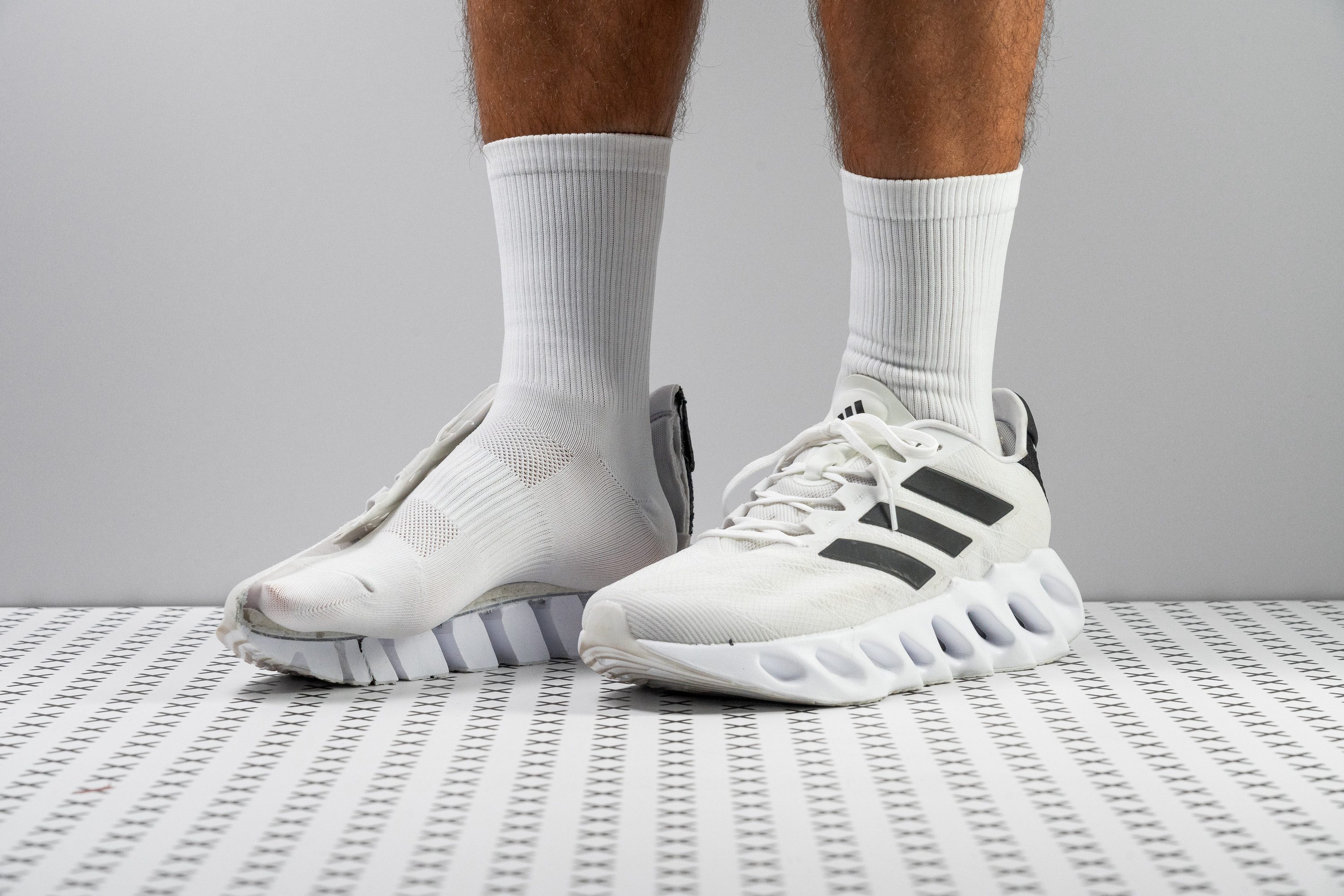Our verdict
Pros
- Really stable
- Enhanced upper durability
- Reduced weight from v1
- Unique aesthetics
- Competitively priced
- Flexible and comfortable for walking
- Nice heel lockdown
- Cheaper than most On models!
- Big reflective elements
Cons
- Limited responsiveness
- Fast-wearing, rock-catching outsole
- Could be more breathable
- Lacks vertical room in upper
Audience verdict
Comparison
The most similar running shoes compared
+ + Add a shoe | |||||
|---|---|---|---|---|---|
| Audience score | 85 Good! | 89 Great! | 80 Good! | 90 Superb! | |
| Price | £120 | £120 | £85 | £170 | |
| Pace | Daily running | Daily running | Daily running | Daily running | |
| Shock absorption | - | High | - | High | |
| Energy return | - | Low | - | Moderate | |
| Traction | - | Moderate | - | High | |
| Arch support | Neutral | Neutral | Neutral | Neutral | |
| Weight lab Weight brand | 10.2 oz / 288g 10.4 oz / 294g | 9.7 oz / 274g 9.5 oz / 270g | 12 oz / 340g 12.5 oz / 354g | 9.6 oz / 272g 9.7 oz / 275g | |
| Drop lab Drop brand | 11.7 mm 10.0 mm | 10.5 mm 5.0 mm | 11.5 mm 10.0 mm | 9.4 mm 6.0 mm | |
| Strike pattern | Heel | Heel | Heel | HeelMid/forefoot | |
| Size | True to size | True to size | True to size | True to size | |
| Midsole softness | Balanced | Soft | Balanced | Balanced | |
| Difference in midsole softness in cold | Normal | Normal | Small | Small | |
| Toebox durability | Decent | Bad | Bad | Decent | |
| Heel padding durability | Good | Decent | Bad | Bad | |
| Outsole durability | Decent | Good | Good | Good | |
| Breathability | Moderate | Breathable | Moderate | Moderate | |
| Width / fit | Medium | Medium | Medium | Medium | |
| Toebox width | Medium | Medium | Narrow | Medium | |
| Stiffness | Stiff | Moderate | Stiff | Stiff | |
| Torsional rigidity | Stiff | Stiff | Stiff | Stiff | |
| Heel counter stiffness | Moderate | Stiff | Moderate | Moderate | |
| Rocker | ✗ | ✗ | ✗ | ✓ | |
| Heel lab Heel brand | 44.0 mm 46.0 mm | 40.7 mm 40.0 mm | 37.7 mm 20.0 mm | 39.9 mm 37.0 mm | |
| Forefoot lab Forefoot brand | 32.3 mm 36.0 mm | 30.2 mm 35.0 mm | 26.2 mm 10.0 mm | 30.5 mm 31.0 mm | |
| Widths available | Normal | NormalWide | Normal | Normal | |
| Orthotic friendly | ✓ | ✓ | ✓ | ✓ | |
| Season | All seasons | SummerAll seasons | All seasons | All seasons | |
| Removable insole | ✓ | ✓ | ✓ | ✓ | |
| Ranking | #218 Bottom 41% | #104 Top 28% | #306 Bottom 18% | #40 Top 11% | |
| Popularity | #266 Bottom 29% | #242 Bottom 35% | #182 Top 49% | #203 Bottom 45% |
Who should buy
We recommend the Adidas Switch FWD 2 for:
- Beginners seeking a highly cushioned shoe, ideal for casual walks and some occasional light runs.
- Runners looking for a high-drop, maximalist trainer that offers surprising stability at a price that’s hard to beat.
- Admirers of the OG Switch FWD who appreciated its unique design but desired a lighter version. Well, it's here.

Who should NOT buy
Despite its bouncy appearance, the Switch FWD 2 falls short in propulsion—making it less ideal for seasoned runners seeking energy return. We've found that alternatives like the On Cloudmonster 2, with its higher stack, or the On Cloudsurfer 7, which offers a more balanced experience, delivers a more energetic ride with a similar midsole design.
Additionally, the Switch FWD 2's high drop may not appeal to runners in search of a less steep shoe. For those who prefer a lower offset coupled with a softer feel underfoot, we recommend considering the ASICS Novablast 4 or the New Balance Fresh Foam X More v5.
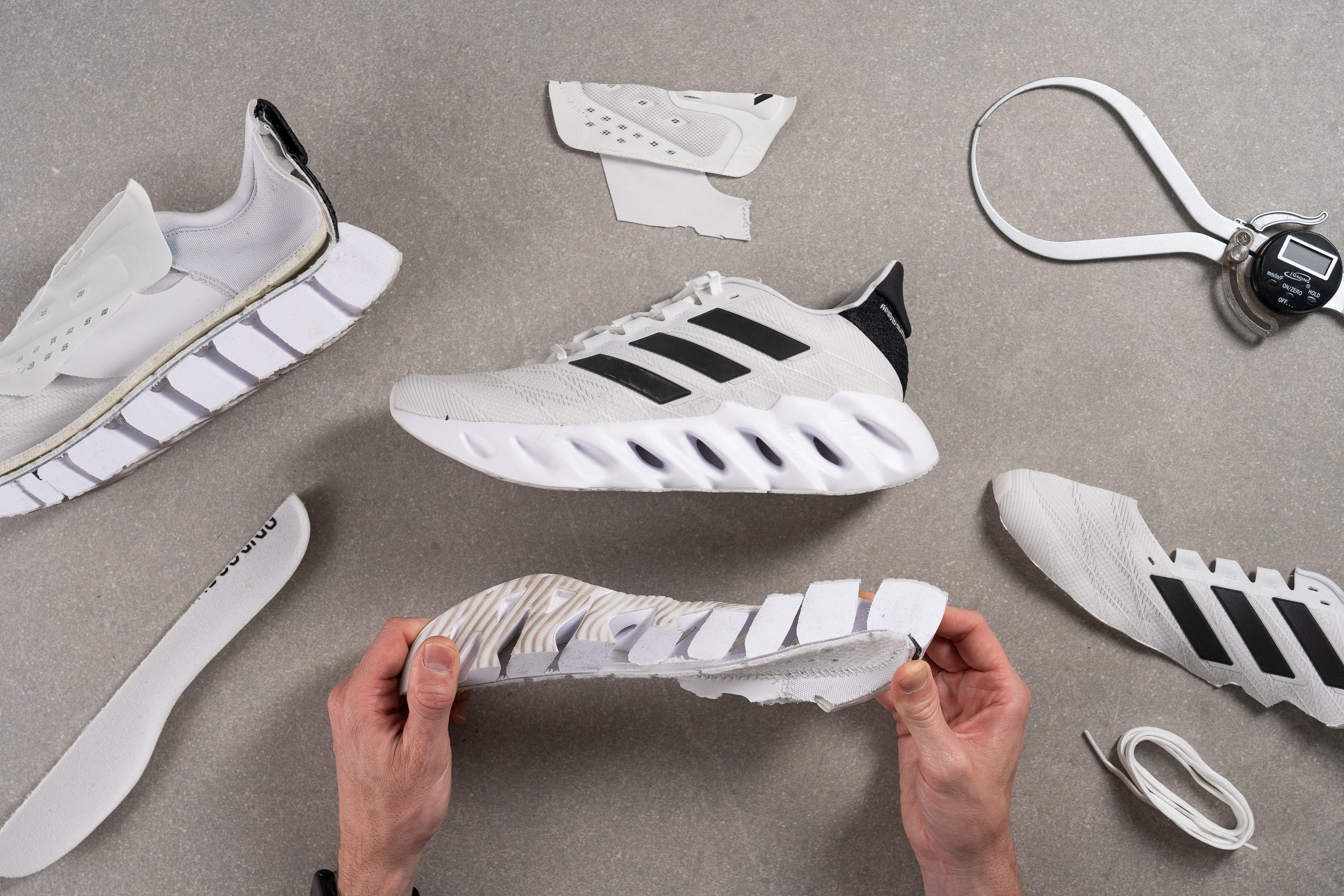
Cushioning
Heel stack
One of the first things we noticed when testing the original Switch FWD series was that the heel stack fell short by 5.2 mm from the advertised height. That’s been fixed too.
We clocked a massive 44.0 mm heel stack in the updated version, and it’s almost comical to look at. We also found that it provides endless cushioning, making it a dream for heavyweight heel strikers.
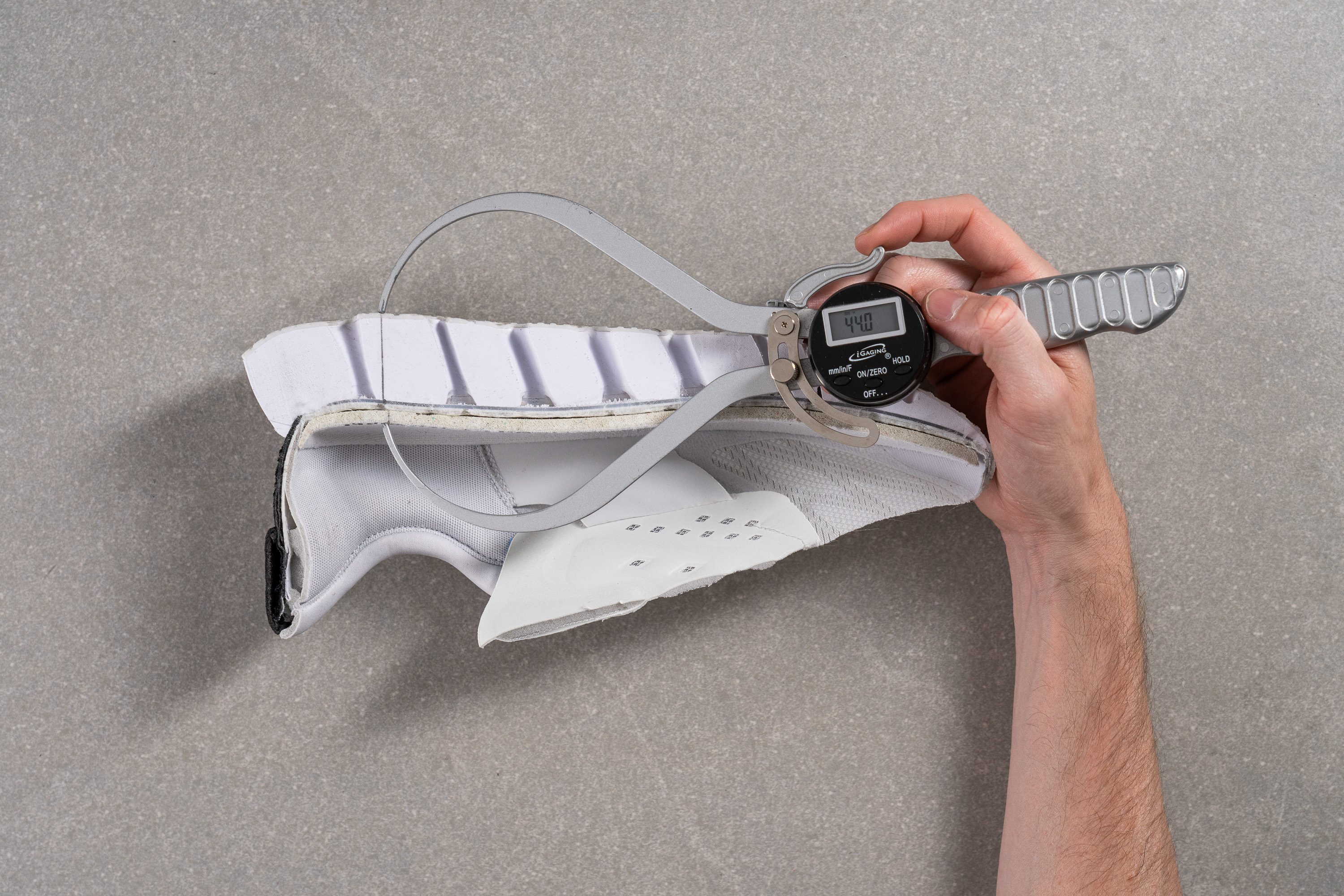
| Switch FWD 2 | 44.0 mm |
| Average | 34.8 mm |
Forefoot stack
The forefoot is also impressively tall, and comes in at 32.3 mm, which isn’t as striking as the heel but still cements this shoe’s place as a true maximalist daily trainer.
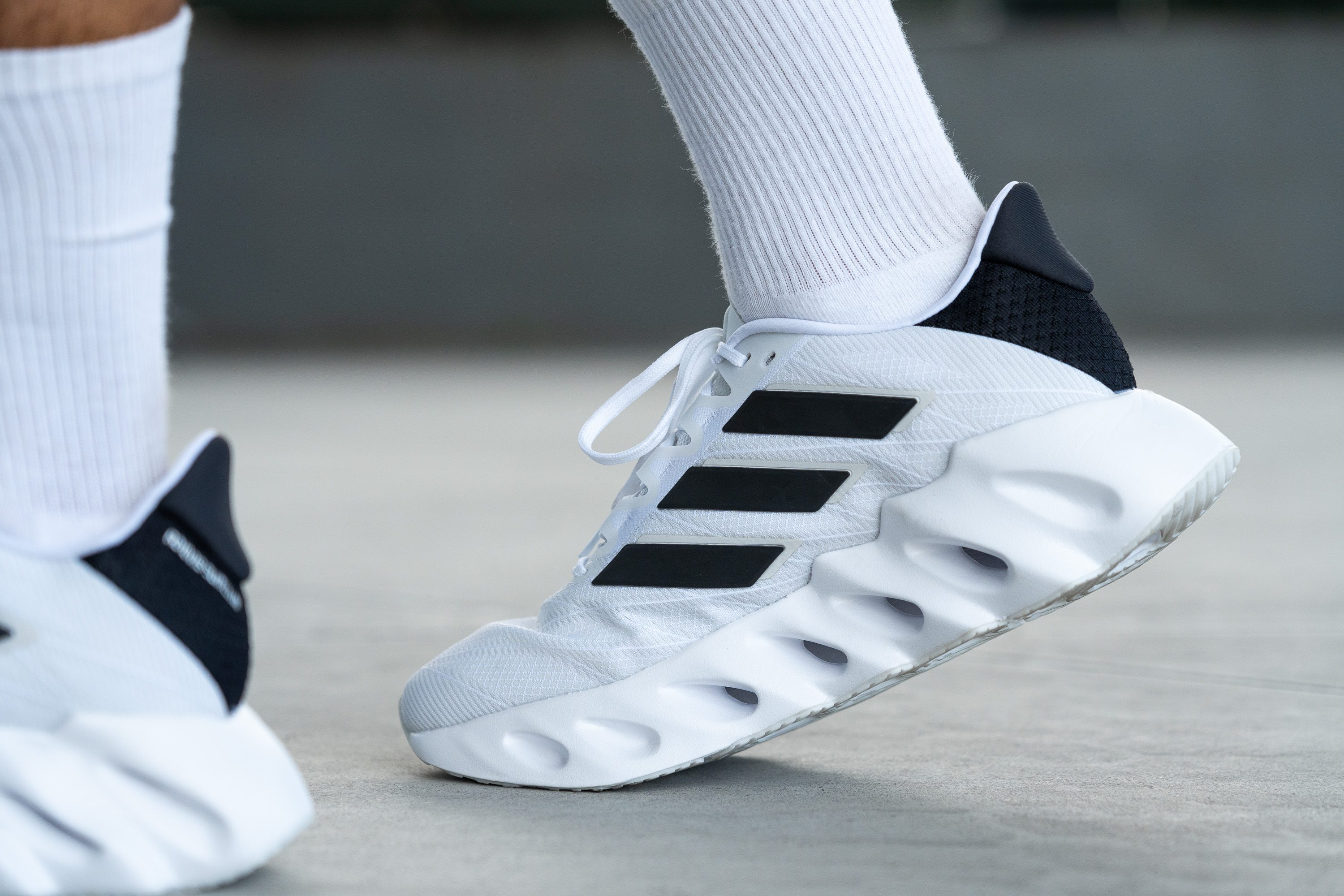
It’s also worth noting that while the forefoot isn’t as high as the heel, it has fewer cutouts in the midsole, meaning the overall net cushioning is similar.

| Switch FWD 2 | 32.3 mm |
| Average | 26.2 mm |
Drop
Just by looking at the cut-in-half Switch FWD 2 in our lab, it’s clear this is a high-drop running shoe. Naturally, we wanted to verify the exact number, and it comes in at 11.7 mm. We found that this makes the shoe much more suitable for heel strikers.
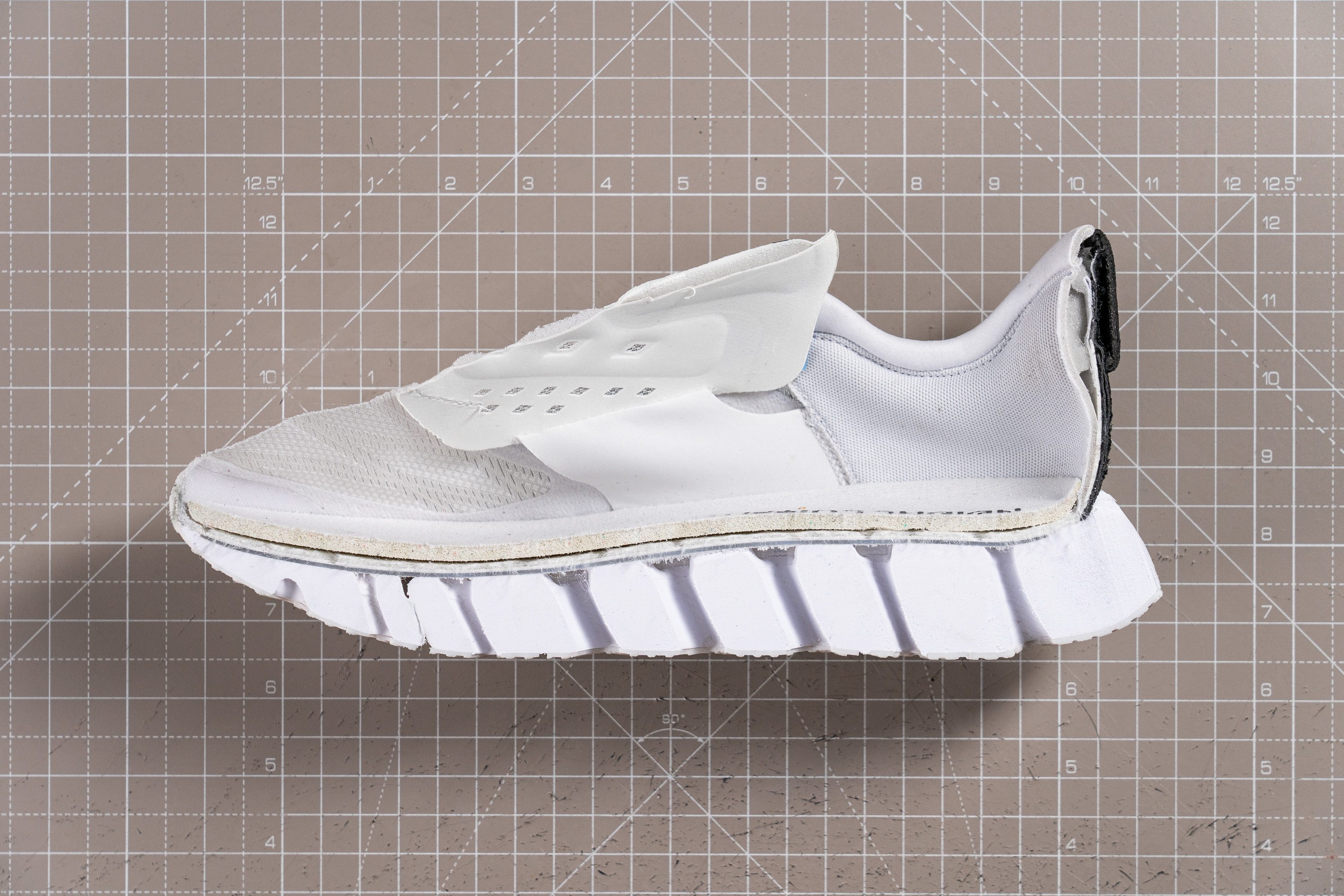
| Switch FWD 2 | 11.7 mm |
| Average | 8.6 mm |
Midsole softness
The most intriguing aspect of the Switch FWD 2, at least on paper, is its On-like midsole design, which immediately stands out from what we typically see in both the lab and on the streets. It promises something different, but the question remains—is it actually any good?
The answer is a bit complicated. Visually, the midsole gives off the impression of being bouncy and reactive, but in reality, it falls short. The EVA foam isn’t as resilient as it appears, and despite its design, there isn’t as much forward propulsion as you might expect.
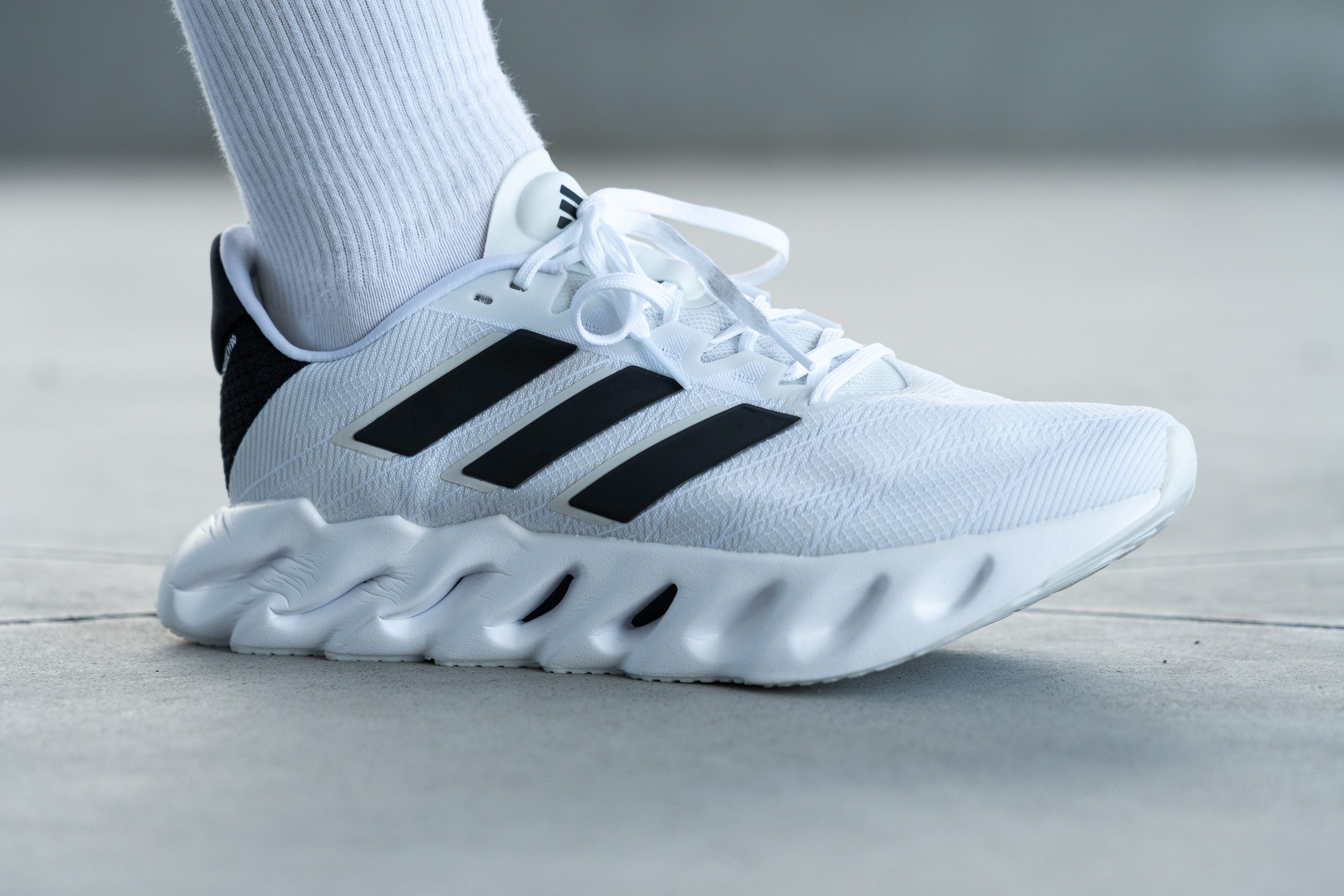
Adidas did improve the overall softness from version 1, changing the foam softness from 27.3 HA to 23.5 HA, but it doesn't fully translate into a significantly softer ride. In fact, the experience still leans toward the firmer side, and we know this comes down to the TPU plate that's above the midsole.

| Switch FWD 2 | 23.5 HA |
| Average | 20.4 HA |
Plate
Adidas incorporated a rigid TPU plate above the midsole in the Switch FWD 2, positioned directly below the insole, and giving a firmer sensation than the foam alone would provide.
While the plate is essential for stability—especially with the tall platform and midsole design—we believe that comfort could be improved with a slightly thicker insole to soften the ride without sacrificing the needed support.

Size and fit
Size
Adidas Switch FWD 2 fits true to size (33 votes).
Width / Fit
With its unconventional design, the fit of this shoe could have gone any direction, yet, our initial width measurement in the lab delivered an average 99.2 mm—consistent with many running shoes.
However, it's crucial to note that the upper doesn't accommodate larger feet well, with noticeably limited vertical volume. Unfortunately, sizing up doesn't alleviate this issue.

This test follows an older methodology, which is why you don't see recently tested shoes in the chart. Results from different methodologies can not be compared.
| Switch FWD 2 | 99.2 mm |
| Average | 98.5 mm |
Toebox width
On a positive note, the toebox of this model doesn't taper as sharply as other Adidas shoes, which are often too pointy.
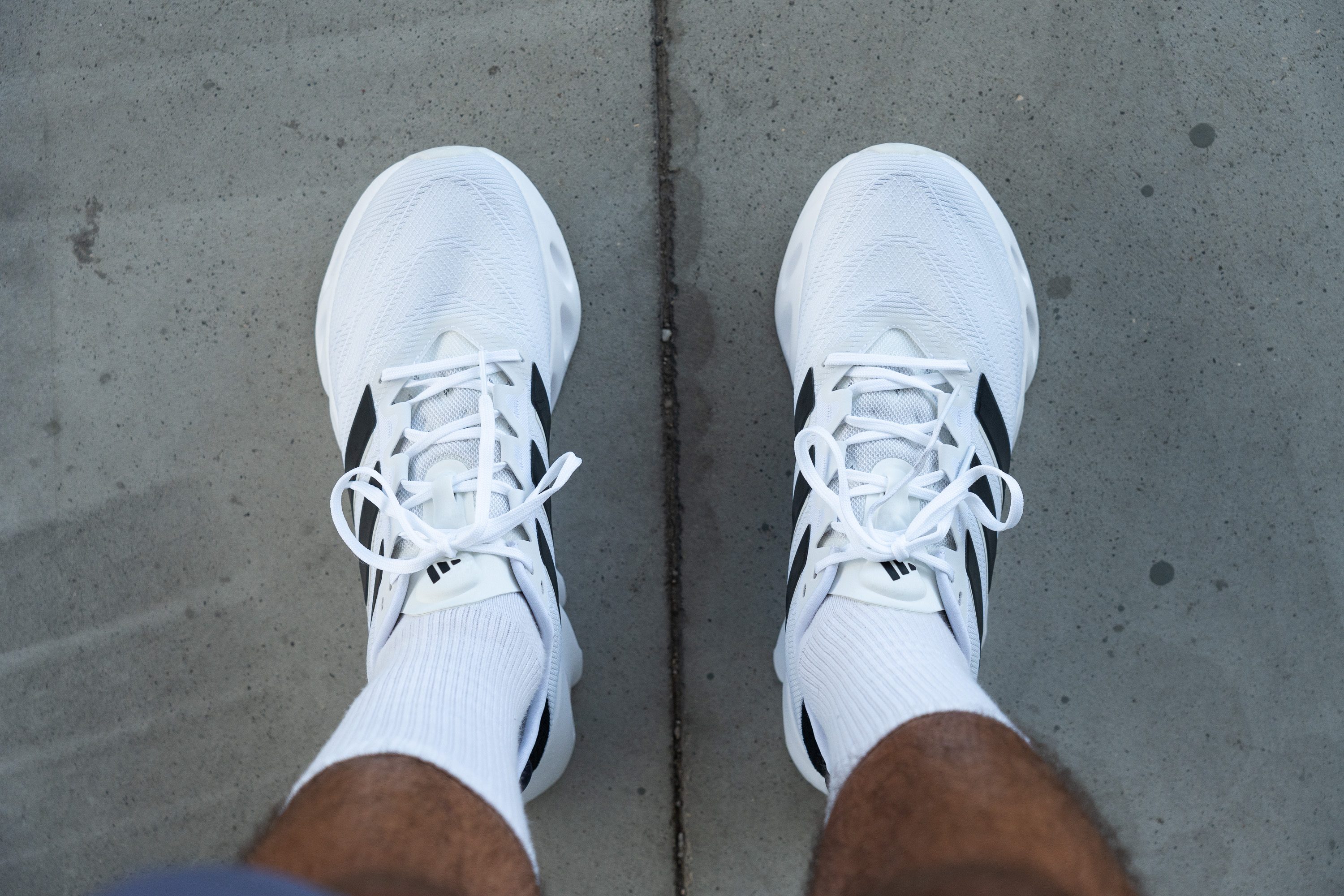
In fact, with a width of 78.9 mm, it provides more room in this area compared to many competitors' models!
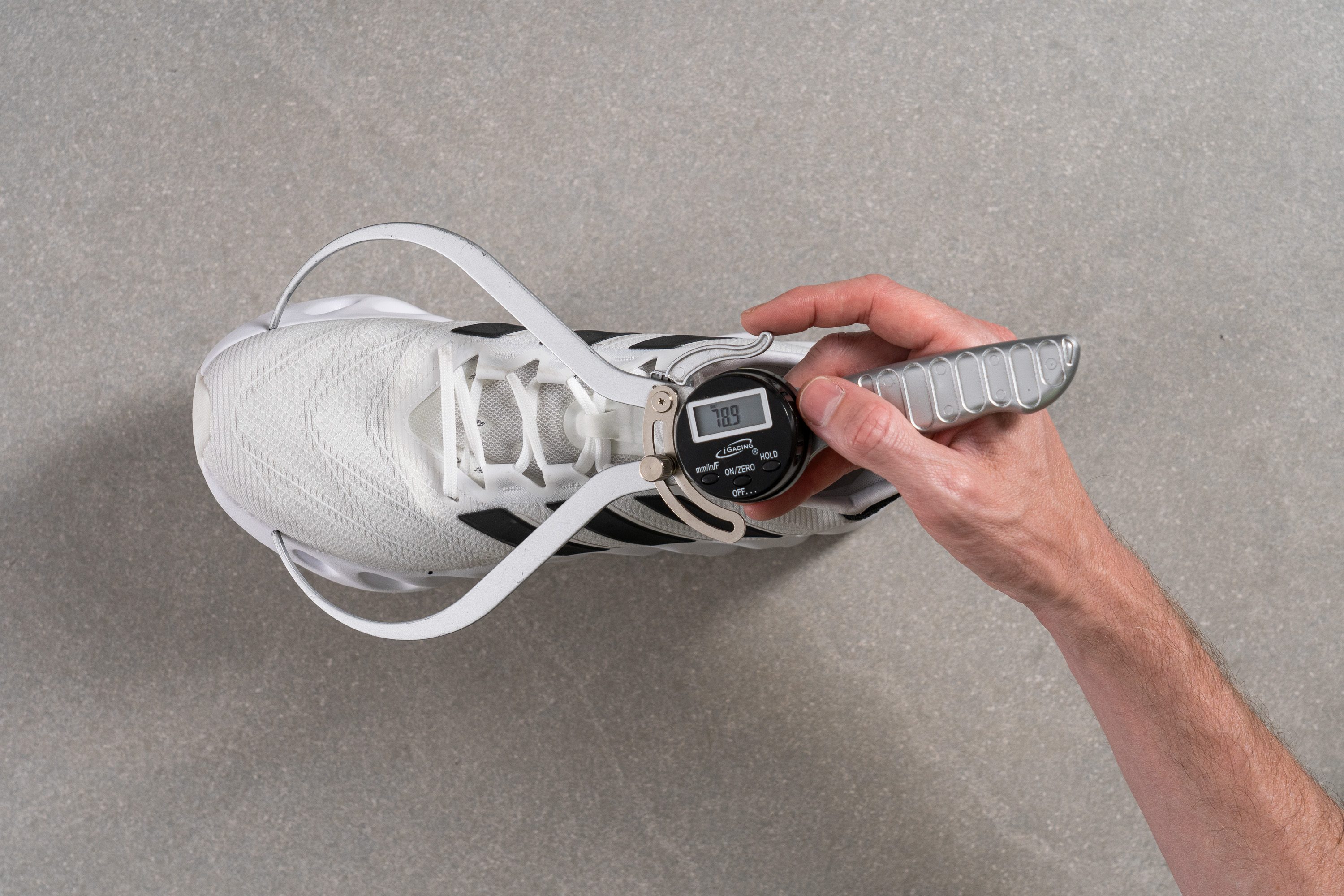
This test follows an older methodology, which is why you don't see recently tested shoes in the chart. Results from different methodologies can not be compared.
| Switch FWD 2 | 78.9 mm |
| Average | 78.4 mm |
Flexibility / Stiffness
The Switch FWD 2 reaffirms a recurrent finding from our lab—contrary to popular belief, neither TPU nor nylon plates significantly enhance longitudinal stiffness in shoes. This model flexed effortlessly under a mere 18.9N in our 90-degree test, making it quite suitable for casual wear—if you can handle the looks, of course.
The flexibility is largely due to the numerous cutouts throughout the midsole and outsole, which serve multiple purposes, including reducing the shoe’s rigidity, as demonstrated here.
This test follows an older methodology, which is why you don't see recently tested shoes in the chart. Results from different methodologies can not be compared.
| Switch FWD 2 | 18.9N |
| Average | 28.1N |
Stiffness in cold (%)
The FWD's stiffness increased up to 38.5% under cold temperatures. However, this is a typical response for a shoe with an EVA midsole, which is known to harden in lower temperatures.
| Switch FWD 2 | 39% |
| Average | 33% |
Weight
One of the major downsides of the original Switch FWD was its hefty weight—11.4 oz or 323g felt excessive, especially for a shoe with so many cutouts in the midsole. Thankfully, Adidas fixed that.
Now at 10.2 oz or 288g, we're much more satisfied with this superb weight reduction. However, this improvement comes at the cost of outsole durability. But if you found the first version clunky and prioritise weight, this update might offer the lighter feel you’ve been waiting for!

| Switch FWD 2 | 10.2 oz (288g) |
| Average | 9.3 oz (264g) |
Breathability
Upon initial inspection, we thought that the Switch FWD 2 seemed less than ideal in terms of breathability. The upper, constructed from a thicker engineered mesh without noticeable holes, suggested potential issues in air flow. So, we brought our lab tools to the test to confirm our impressions.
Our smoke-pumping machine offered concrete evidence—the FWD 2’s breathability indeed falls short. Achieving only a 3/5 rating, this result is below average for a road running shoe, indicating that the shoe performs better in cooler conditions rather than during hot summer runs.
Further testing involved illuminating the upper with a strong LED light to see how much passed through. While some light filtered through the toebox, the majority of the shoe presented a dense and structured material composition that effectively retains heat, not ideal for high temperatures.
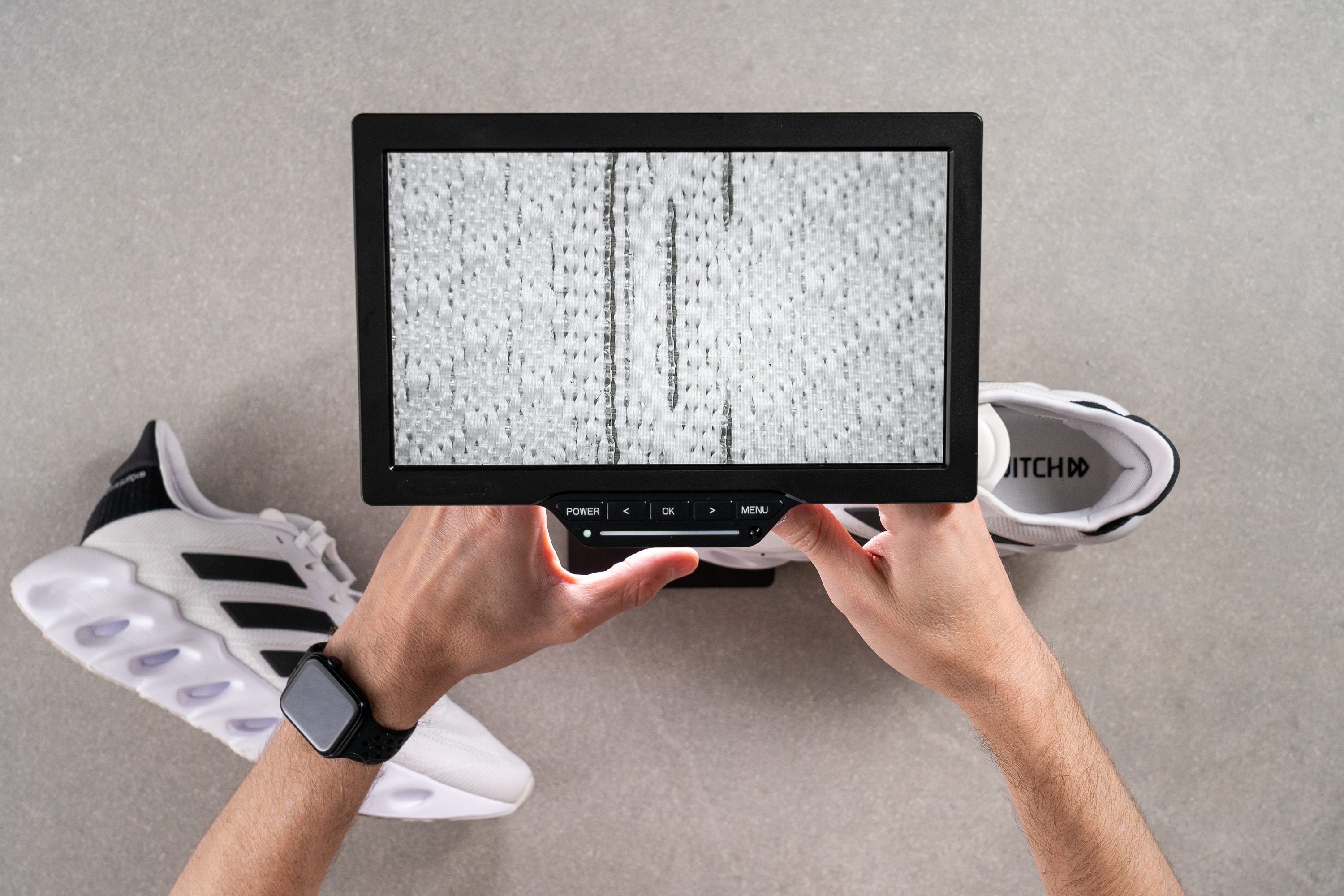
Under the microscope, we discovered tiny vertical gaps strategically placed by Adidas to try to enhance ventilation. Although these gaps provide some relief, their impact is not enough, yet without them, the shoe’s breathability score would have likely been disastrous.
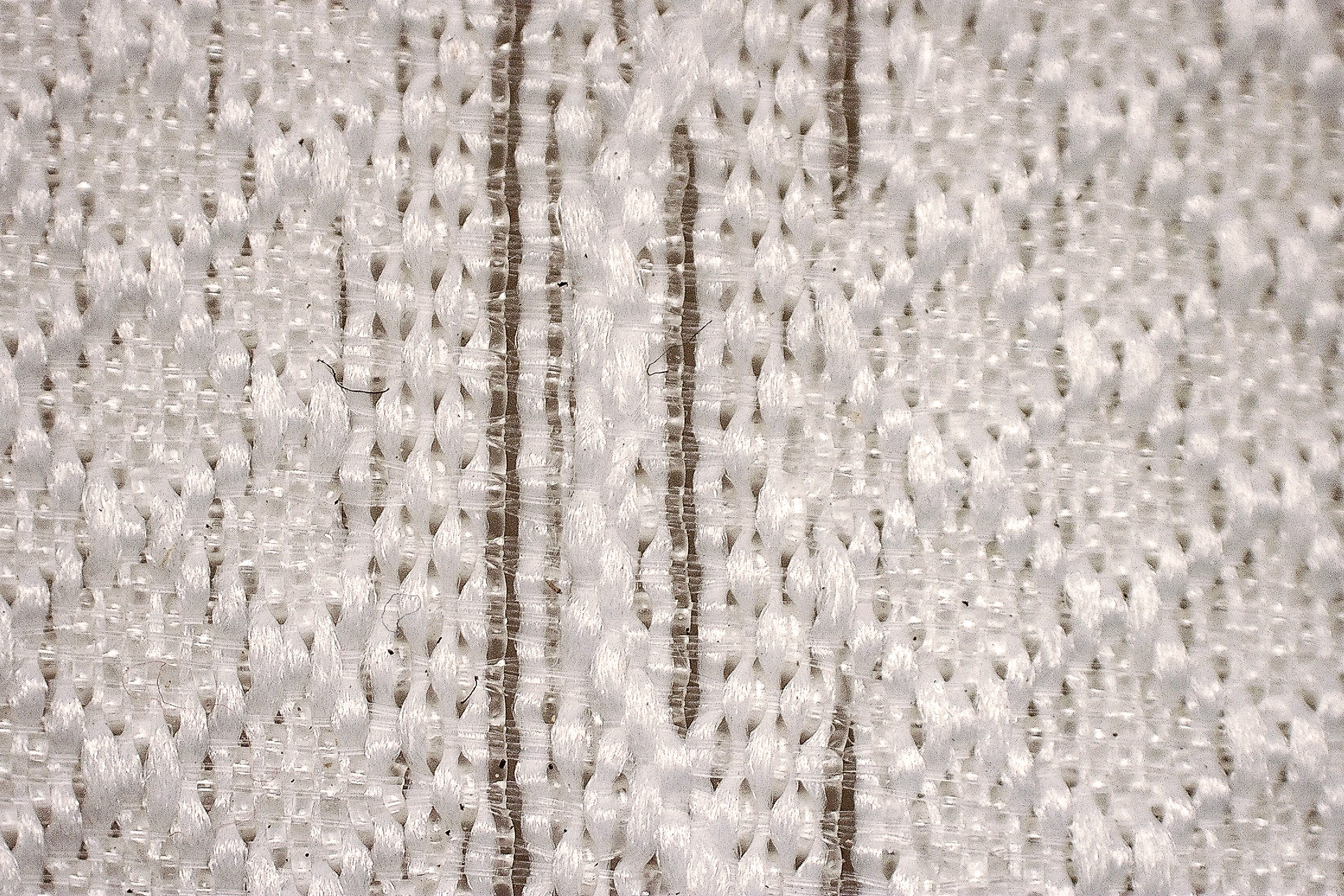
The overall breathability and structure of the upper also revealed it's not designed for sockless running at all. It lacks the necessary stretch and padding found in more forgiving trainers and includes several exposed seams that could cause discomfort, confirming our initial observations.
| Switch FWD 2 | 3 |
| Average | 3.7 |
Stability
Lateral stability test
The Switch FWD 2, despite its towering height and somewhat narrow appearance—especially from the back—surprised us with its impressive stability. We found this to be one of its standout and unexpected features!
Torsional rigidity
Several features enhance the stability of the Switch FWD 2, including its firm EVA foam. And another thing that contributes in terms of support is its high torsional rigidity. We tested it manually and gave it a 4/5 rating for resistance to bending—thanks to the full-length TPU plate that Adidas integrated.
| Switch FWD 2 | 4 |
| Average | 3.5 |
Heel counter stiffness
We found that the heel counter of the FWD 2 strikes a great balance in terms of stiffness. It’s moderately firm, which we rated at 3/5, providing enough support without feeling overly rigid. This makes it suitable for a variety of runners, ensuring both stability and comfort!
| Switch FWD 2 | 3 |
| Average | 2.9 |
Midsole width - forefoot
What truly caught our attention after initially examining the midsole was the incredibly wide forefoot. We measured it at 122.4 mm, offering an impressively broad landing platform.
Most runners can benefit from its stability and cushioning, although as we said before in the "drop" section, it's better suited for heel strikers or midfoot/forefoot strikers who need a higher offset.
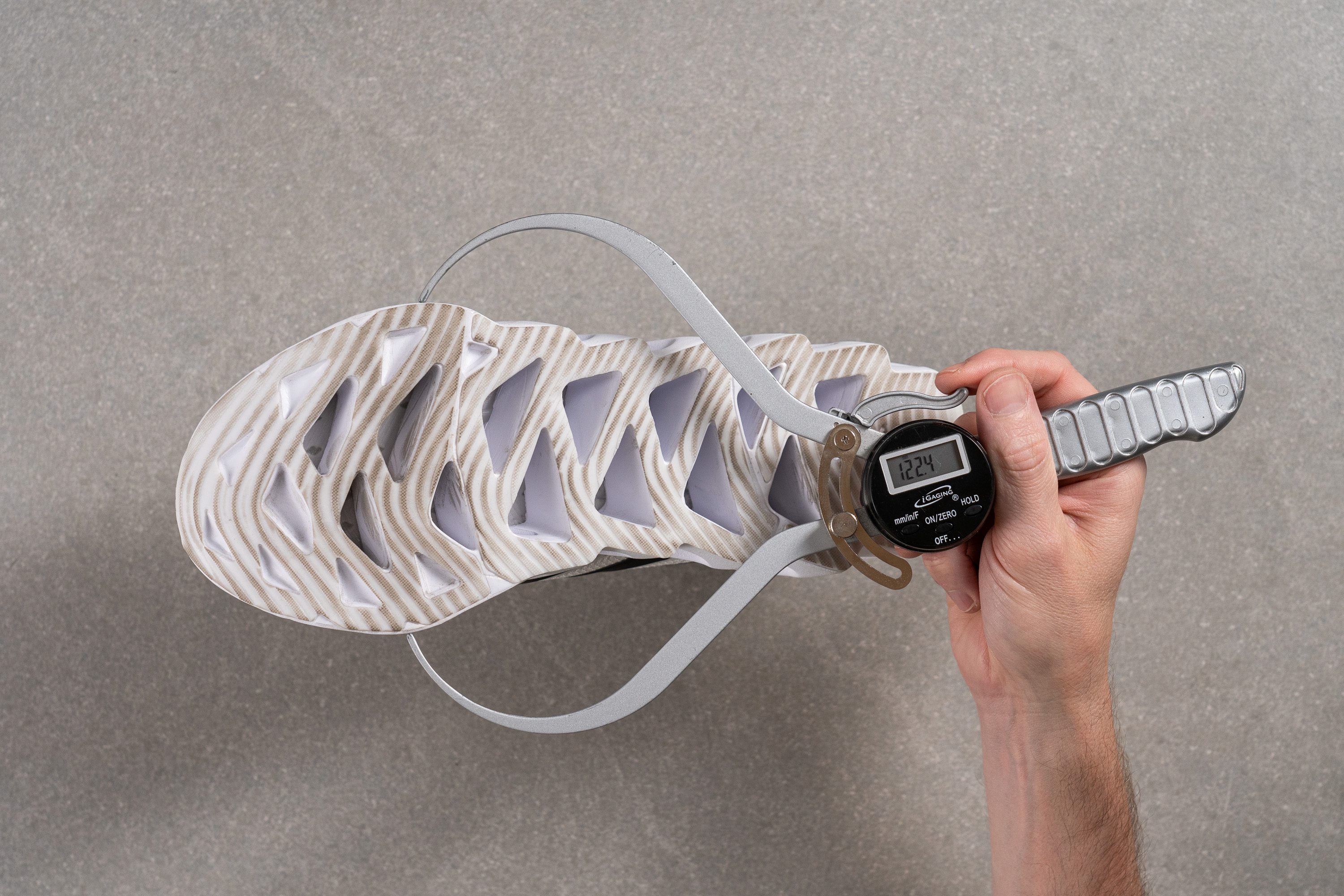
| Switch FWD 2 | 122.4 mm |
| Average | 114.4 mm |
Midsole width - heel
We were taken aback to find that, despite the expansive forefoot width clocked at a staggering 122.4 mm, the heel measured a mere 89.4 mm—quite average by comparison! This design choice by Adidas is a bit puzzling, particularly as this shoe caters primarily to heel strikers and it's uncommon to see such a discrepancy between forefoot and heel widths.
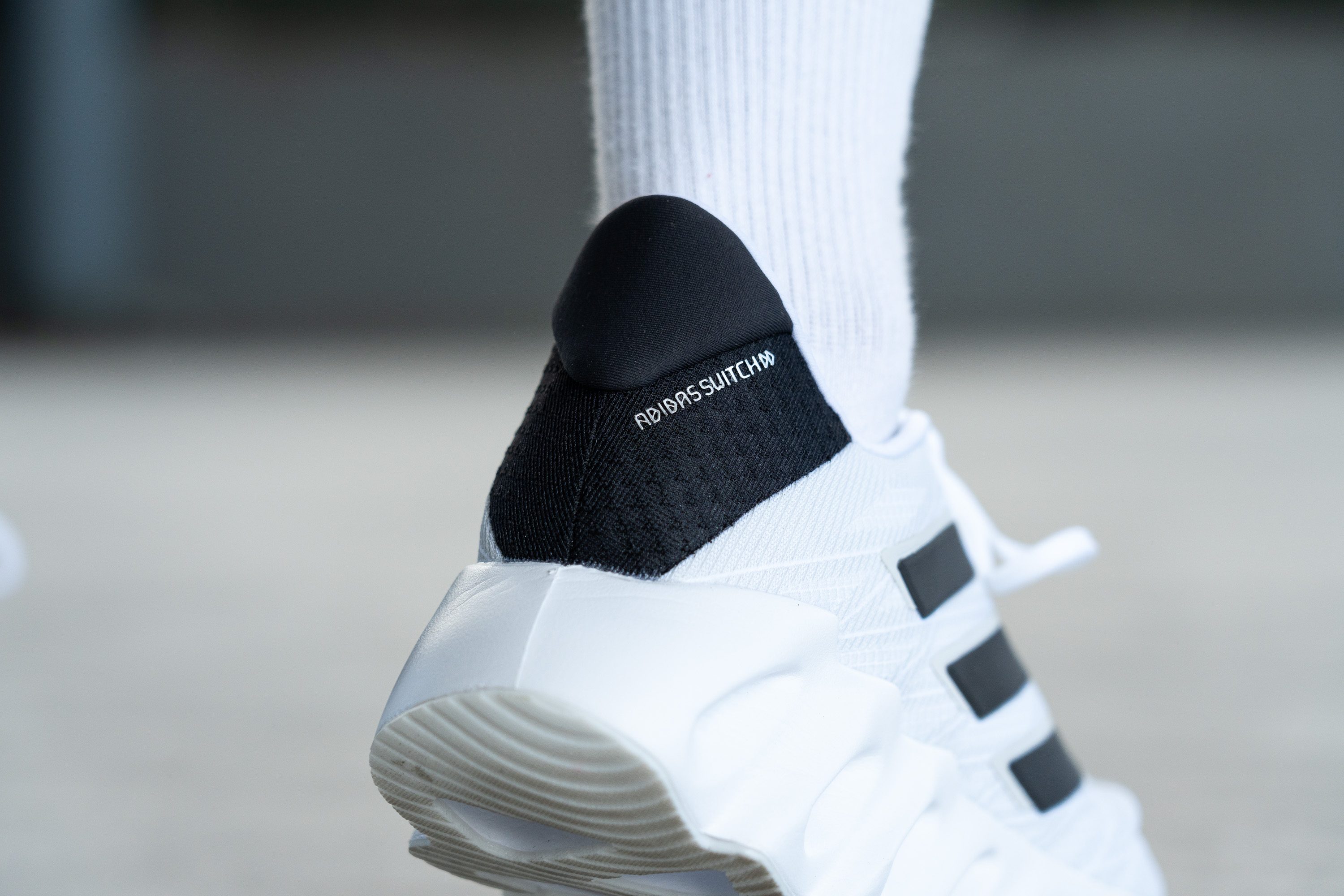
However, the shoe runs more stable than its appearance might suggest, which could be attributed to its overall weight. Balancing a broader build without increasing weight seems to have been a challenging feat for Adidas.
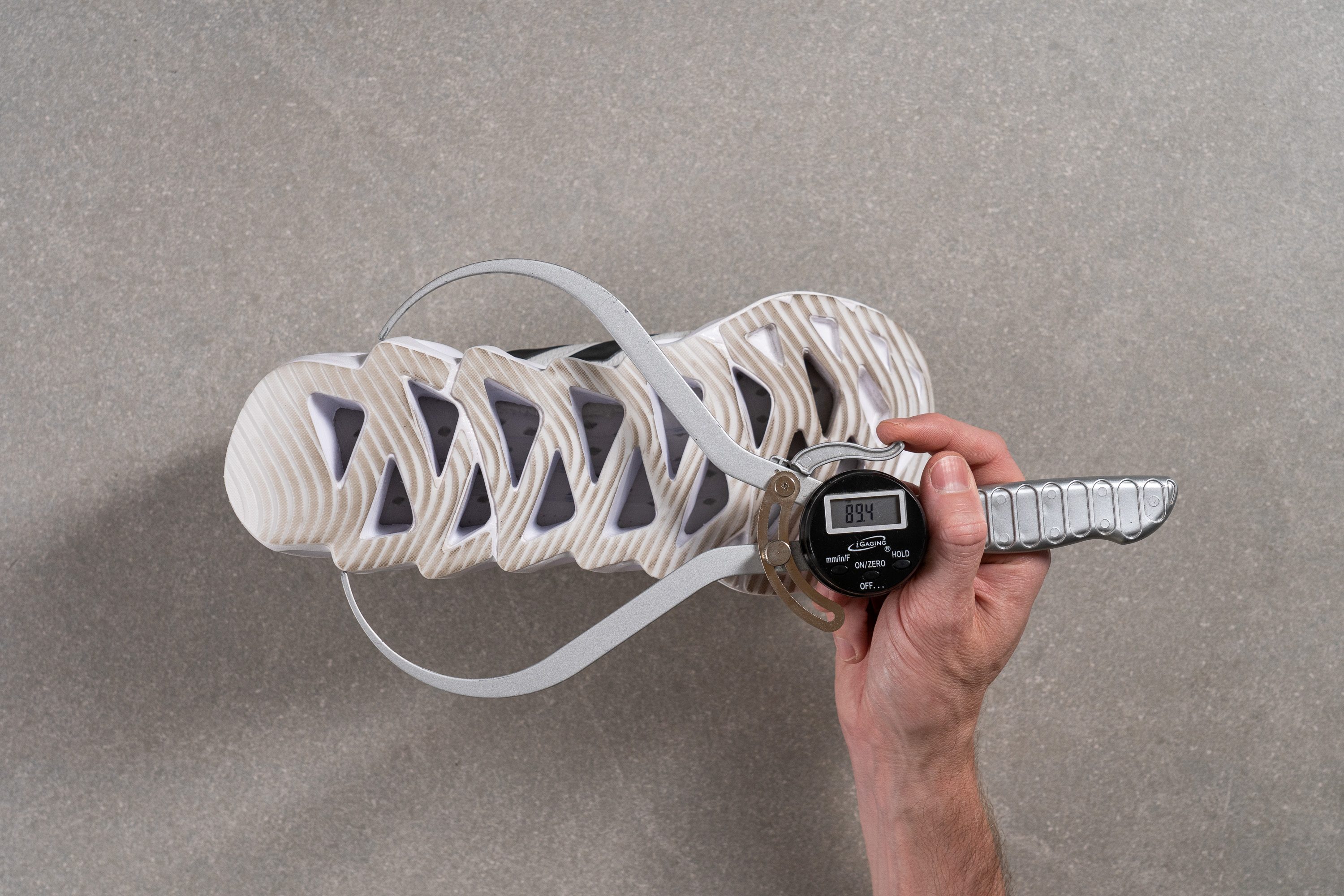
| Switch FWD 2 | 89.4 mm |
| Average | 90.7 mm |
Durability
Toebox durability
Once we accepted the lack of breathability in this upper, we turned our attention to durability, often a strong suit of denser fabrics. And we were especially hoping for a better result this time, as the first-gen Switch FWD performed poorly in this test.
We put it through its paces with our Dremel set to 3.2N of force and 5,000 RPM. We found that the Switch FWD 2 held up decently, earning a respectable 3/5 score, placing it in the middle of the pack for durability. While it wasn’t outstanding, it proved capable of handling the challenge!
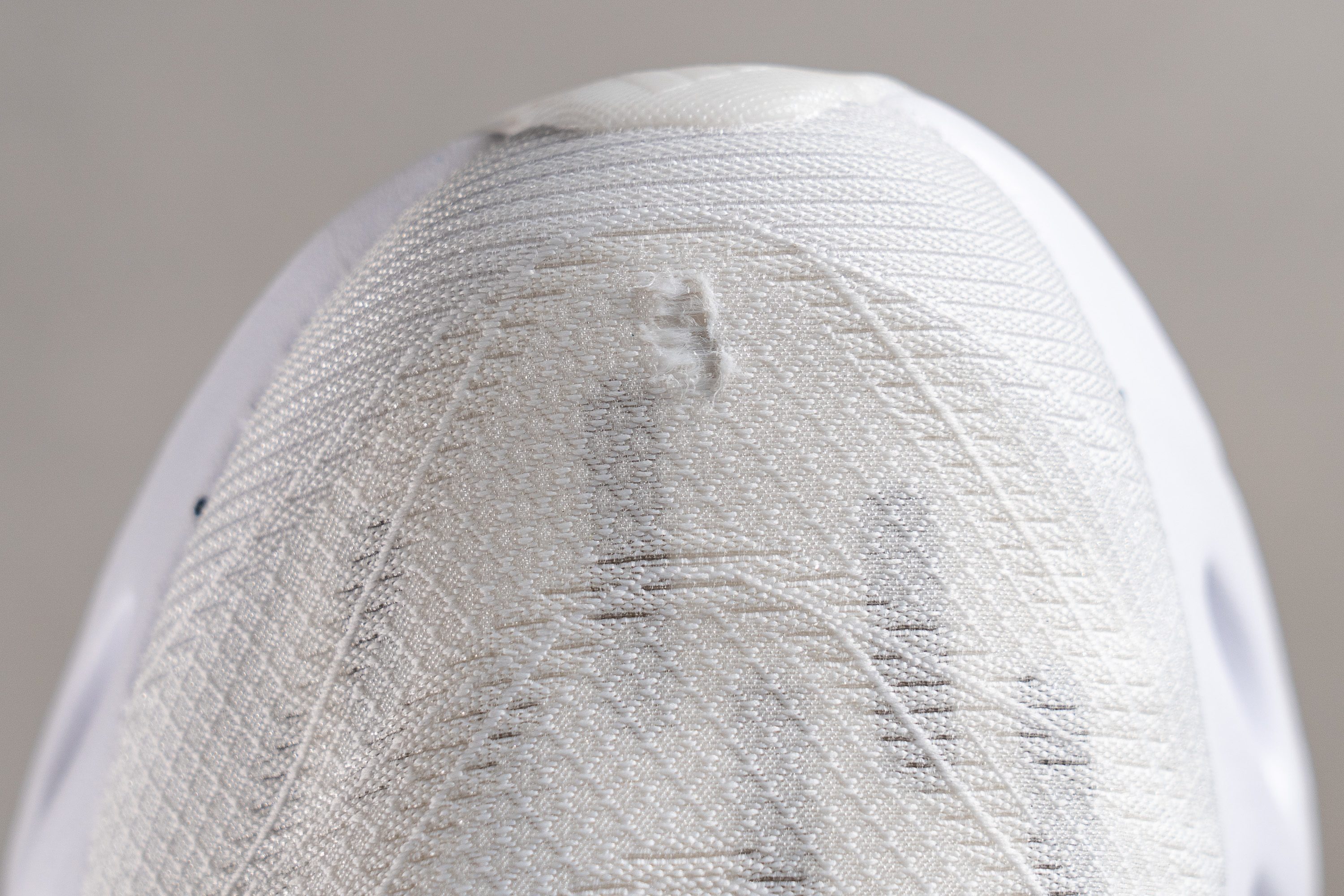
| Switch FWD 2 | 3 |
| Average | 2.6 |
Heel padding durability
The heel collar of the Switch FWD 2 has a unique design—extra padding on the interior locks in the Achilles, preventing any heel slip, while the collar extends higher.
When it came to durability, it outperformed the toebox, scoring a solid 4 out of 5 in our tests. We believe that this design ensures both comfort and long-lasting performance.
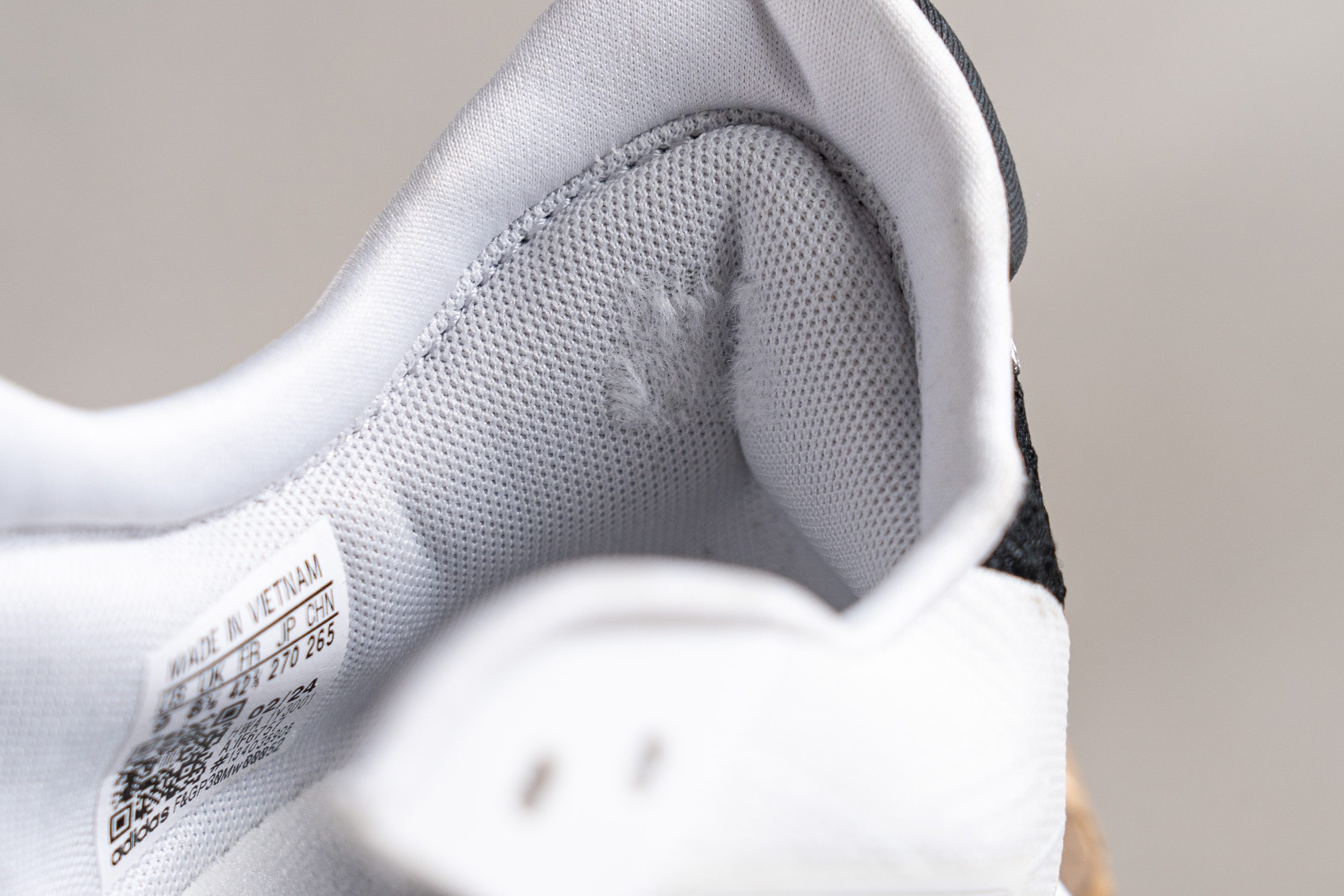
| Switch FWD 2 | 4 |
| Average | 3.4 |
Outsole hardness
The outsole has seen significant changes from the previous generation, though not all for the better in terms of design—it remains a real rock-catcher due to the big gaps that extend up to the insole.
When it comes to grip, however, it excels thanks to the famous Continental rubber.
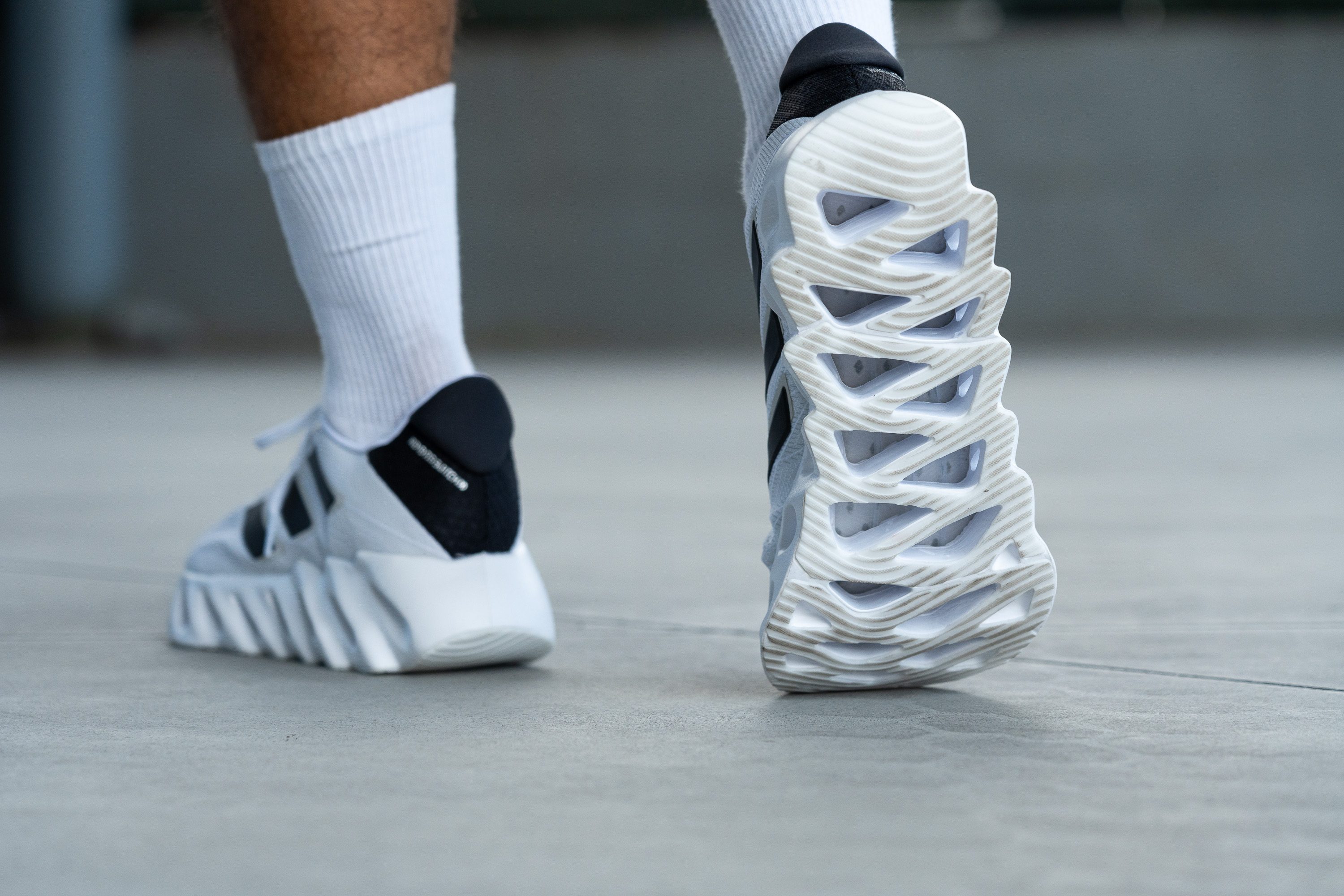
Interestingly, Adidas didn't stamp the Continental logo on the outsole like in the first version. We tested the rubber and found it's a softer blend than expected—72.6 HC—which could impact durability over time.

| Switch FWD 2 | 72.6 HC |
| Average | 79.2 HC |
Outsole durability
Our worst fears were confirmed when we used the Dremel for the third and final time in today's lab session.
After the tool finished, we found a disappointing 1.6 mm mark in the rubber. This is undeniably a bad result and a clear downgrade from the first generation.
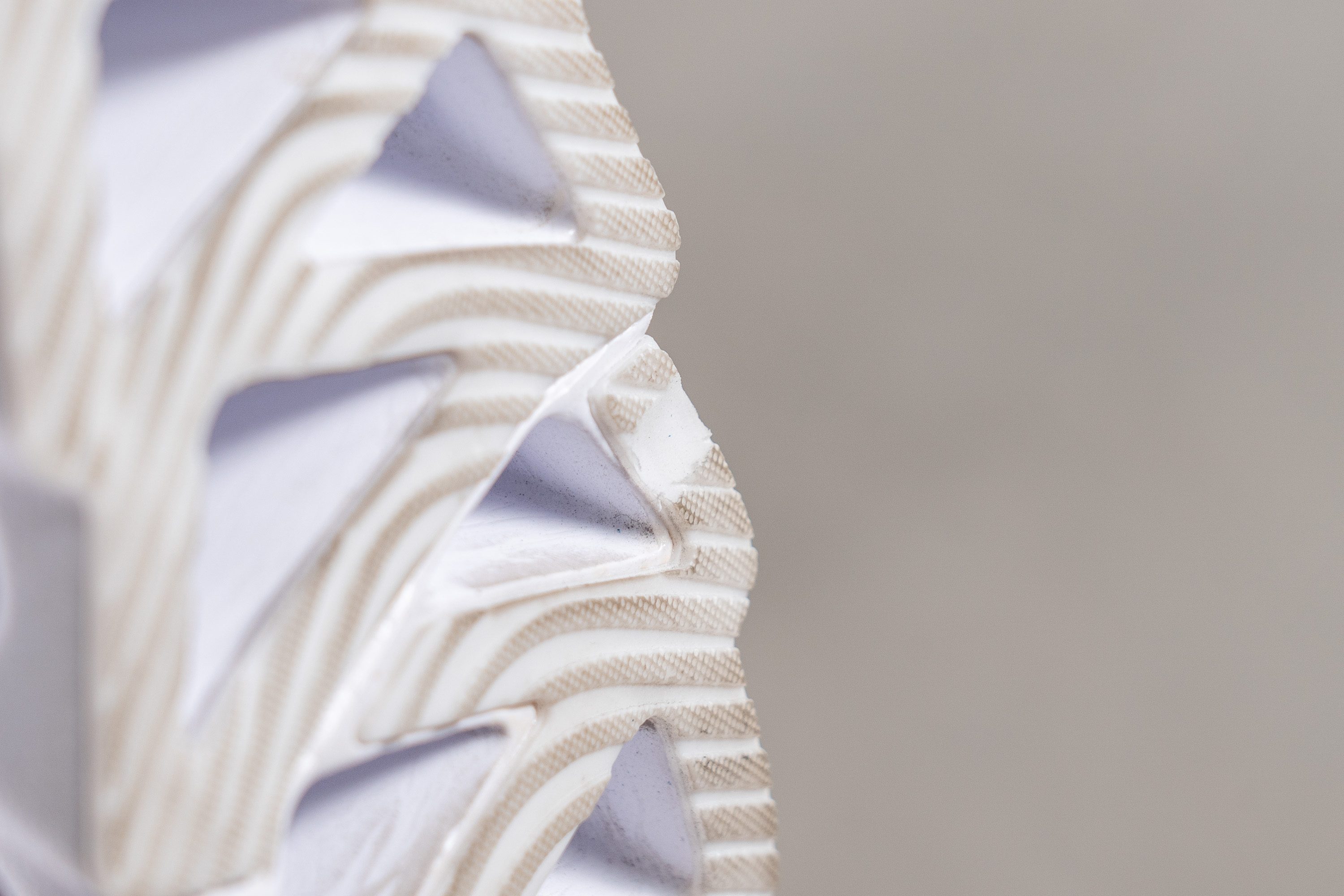
| Switch FWD 2 | 1.6 mm |
| Average | 1.1 mm |
Outsole thickness
We found that the rubber is just 2.3 mm thick—1.0 mm thinner than in v1—making this shoe difficult to recommend for runners who wear down outsoles quickly.
We also noted a significant reduction in ground contact surfaces compared to other shoes, meaning wear and tear will likely happen faster than in most daily trainers. This could be a dealbreaker for those looking for longevity in their footwear.
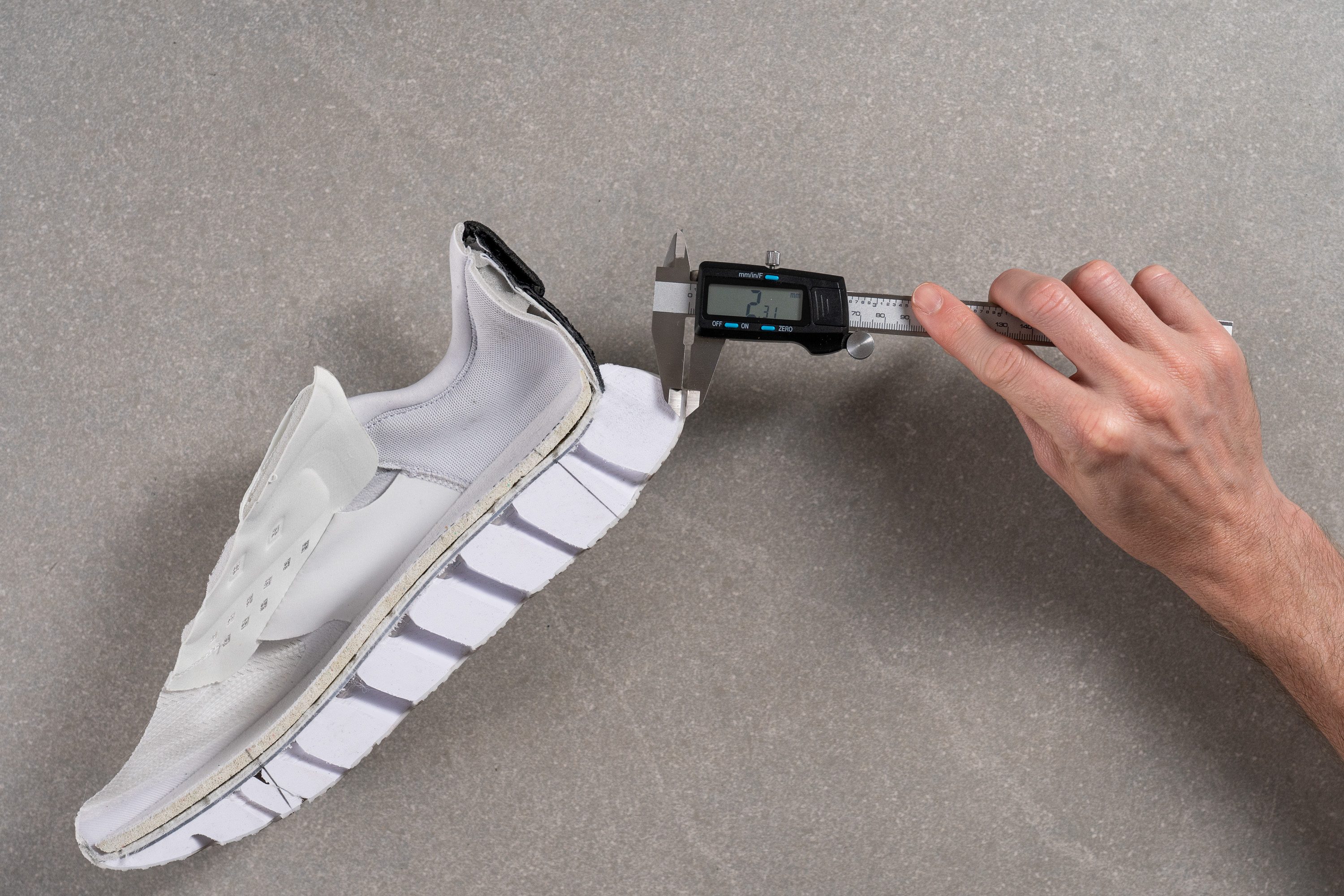
| Switch FWD 2 | 2.3 mm |
| Average | 3.2 mm |
Misc
Insole thickness
The insole is made from recycled EVA foam and is one of the few elements in this shoe that seems to be fairly standard. It measures 4.8 mm in thickness, providing a straightforward, no-frills design.
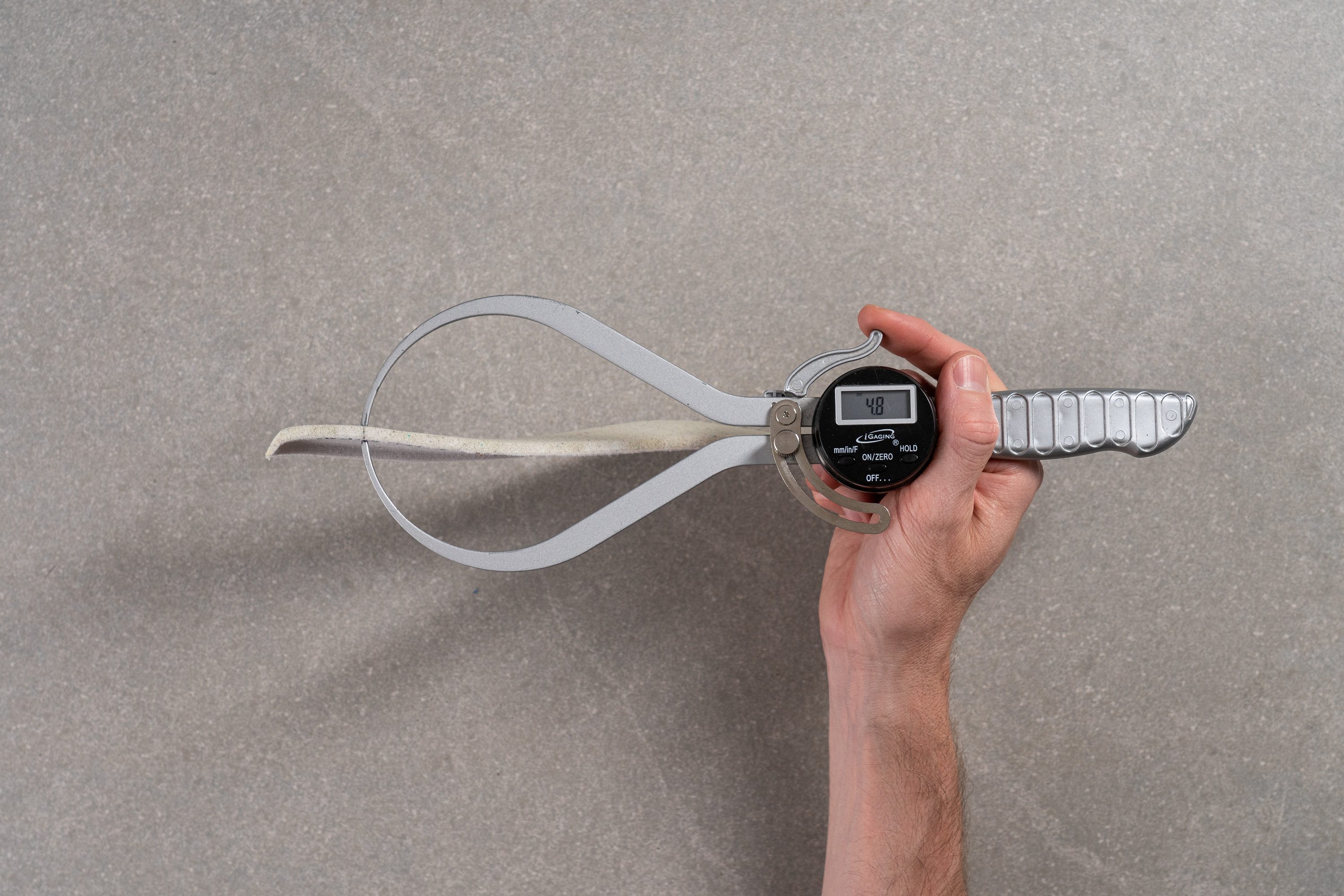
| Switch FWD 2 | 4.8 mm |
| Average | 4.5 mm |
Removable insole
We encountered no problems replacing the insole of the FWD 2, and it's a change that probably won't be harmful—since the original footbed is quite basic.

| Switch FWD 2 | Yes |
Midsole softness in cold (%)
We tested the FWD 2 in cold conditions by placing it in the freezer for 20 minutes. The foam's softness changed by 27.1%, which we consider a typical change for EVA compound
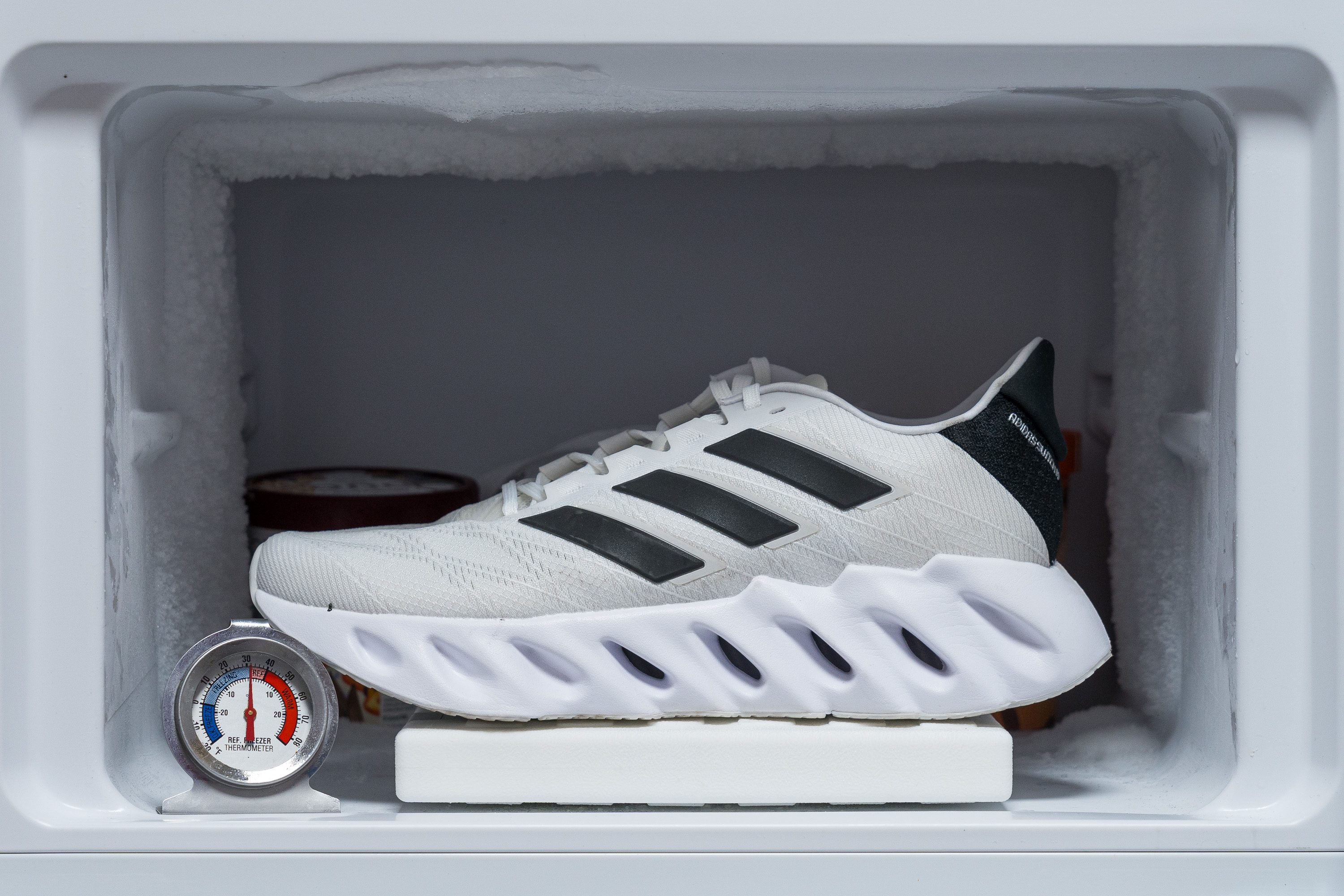
| Switch FWD 2 | 27% |
| Average | 24% |
Reflective elements
Few daily trainers incorporate reflective features, yet the Switch FWD 2 stands out—its large Adidas stripes not only catch the eye but also reflect light, enhancing safety during your runs.
| Switch FWD 2 | Yes |
Tongue padding
The tongue of the OG Switch FWD was one of its best features for its comfort and streamlined design. And we were pleased to discover that the second generation maintains the same 5.0 mm padding.
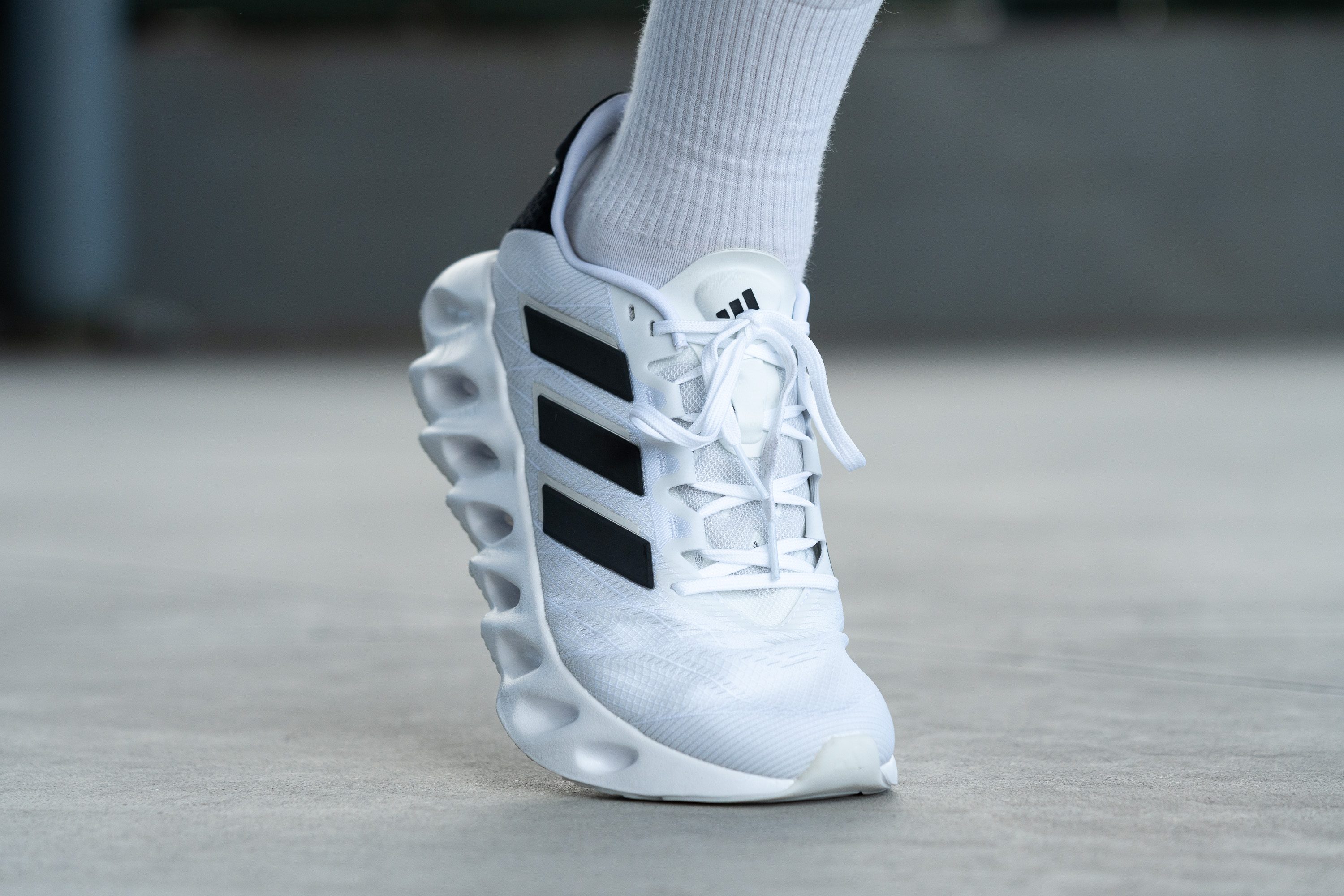
In our experience, this is the ideal setup for daily use—perfectly balancing lightness with comfort and avoiding any bulkiness. Although the hybrid lacing system isn't the best we've encountered in the lab, mainly due to its lace loops, it still performs effectively.
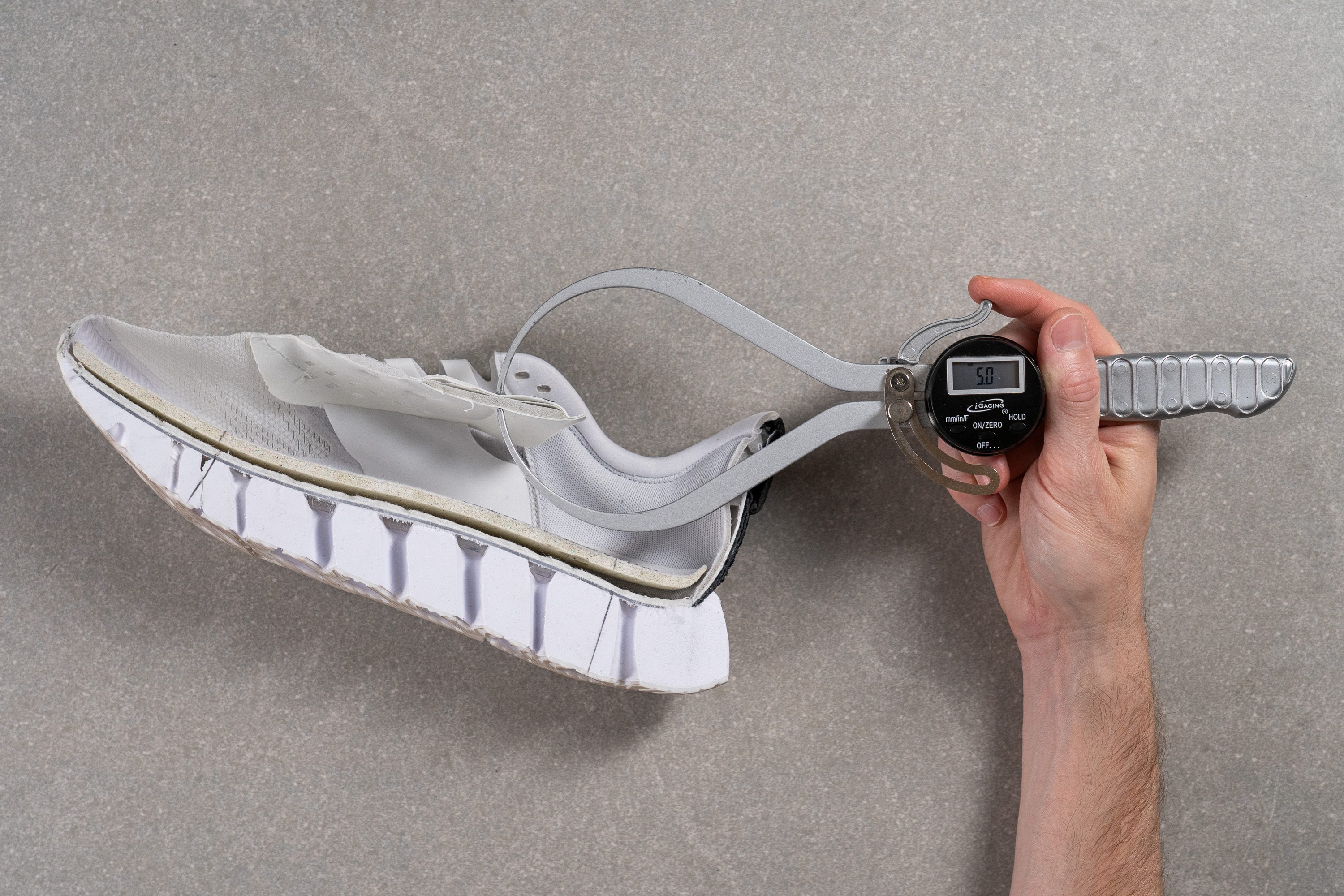
| Switch FWD 2 | 5.0 mm |
| Average | 5.8 mm |
Tongue: gusset type
It's not common for a shoe priced at £140 to feature a tongue that's fixed to the sides—yet, we discovered that the Switch FWD 2 does just that, much to our delight.

| Switch FWD 2 | Both sides (semi) |
Price
One aspect of this shoe that doesn't look weird is its price—surprisingly, it matches the average cost of other running shoes in its class and notably avoids a price increase from the previous version, which is a rare find in today's market!
| Switch FWD 2 | $140 |
Heel tab
While the heel of the Switch FWD 2 is impressively cushioned, it misses a heel tab—a convenient feature found in the Adidas Adizero line for easy pulling on.

| Switch FWD 2 | None |

